Jun 4, 2020 | coins, counterfeit, Eagles, education, silver

Want more information about American Eagle Coins?
The Coin Collectors Handbook: American Eagle Coins has more information and is fully illustrated. Read more →
here;
UPDATE: I BOUGHT TWO COINS FROM THIS COMPANY. THEY ARE FAKE, AS SUSPECTED. Read more →
here!
If a deal is too good to be true, it probably is.
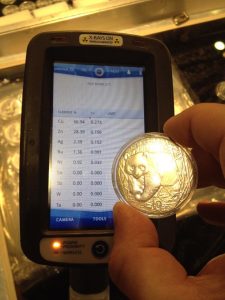
Device that could metallic analysis of a coin below the surface
The company is named LIACOO. Please note the two “ohs” because there is a legitimate company spelled with a single “oh.” LIACOO appears to be selling knock-off products made in China and representing them as genuine for less than market value.
A reader purchased five of these coins. After they arrived, this person said that something looked wrong and asked for help. The images that were sent makes the coins appear to be cast copies of American Silver Eagle coins. COUNTERFEITS!
First, you will NEVER find a legitimate seller sell American Silver Eagle for less than the wholesale price. You may be able to find someone who will round down your cost to the nearest dollar as a loss leader, but the price will never be more than 1-2% less than the spot price. The current spot price of silver is $17.84. If you find someone selling legitimate American Silver Eagle for $17.00-17.50, they will probably sell the coins to convince you to do further business with them. Otherwise, you may want to check the company further.
In this case, an examination of their website has no information about who they are.
- There was no physical address.
- There was no telephone number listed.
- The site did not have a privacy policy required to do business with most of the world.
- The site did not have any policies for shipping, returns, or customer service.
- The pictures of legitimate monster boxes and roll containers were “borrowed” from another site.
There are two places where they provide contact information. On their FAQ page is an email address that uses a different domain. Contact information for the company’s domain name appears on one page that listed an email address, and that customer service was available between 9a and 5p HKT. HKT is the time zone abbreviation for Hong Kong Time.
If that was not enough to convince you that this deal is too good to be true, further research went into their Internet presence.
Their domain name registration shows that the name was purchased from a company in Guangdong, China, that appears to service small businesses. This service provider is reselling the services offered by Baidu. Baidu is a Chinese state-controlled search engine, sometimes called the Google of China. The Chinese government heavily regulates Baidu.
The website is hosted on servers owned by Alibaba. Alibaba is a China-based e-commerce conglomerate whose ties with the Chinese government is uncertain. Although founder Jack Ma has claimed to have no government ties, it is essential to remember that the Chinese government regulates everything and censor Internet traffic inside its borders.
Everything regarding their Internet presence confirms that they are a China-based company. Remember, many of the worst counterfeit coins have origins in China.
I provided the details of the clues I was looking for to help you understand how to spot a scammer. I went further by looking into their Internet presence since I have the background to understand the under-the-hood workings of the Internet. However, my examination of the website was enough to convince me not to buy the coins.
If anything about the offer makes you uneasy, then do not buy the coins. If you want me to look at the site, leave a message in the comment section below, or send me a note. “Let’s be careful out there.”
May 4, 2020 | bullion, commentary, counterfeit, news
 This past week has been interesting for the precious metals markets. When the market seems like it will take off, prices modulate and lay flatter than a pancake. Predictions as what the markets will do are all over the place without a consensus answer from analysts.
This past week has been interesting for the precious metals markets. When the market seems like it will take off, prices modulate and lay flatter than a pancake. Predictions as what the markets will do are all over the place without a consensus answer from analysts.
It reminds me of the quote attributed to President Harry S. Truman, “Give me a one-handed Economist. All my economists say; ‘on one hand…,’ then ‘but on the other….’”
This past week, the Anti-Counterfeiting Educational Foundation (ACEF) weighed in with another problem in this market: COUNTERFEITING!
Counterfeiting is not a new problem. What makes the problem more pronounced is that with much of the country staying home and Internet usage increasing, the number of websites trying to scam people out of money has risen. ACEF has been monitoring the problem and has reported over 100 websites selling counterfeit coins and bullion to government enforcement agencies.
Many of these counterfeiters create slick websites. Not only is it easy to create professional-looking sites with modern tools, but it is easy to copy information from one website to another. Once the scammer has the information they want, it is easy to repurpose it to scam people. They also copy the text from legitimate websites, especially if English is not their first language. It is easier to steal the text than have to create their own.
- If the price is too good to be true, it is probably a scam. Check a site like kitco.com for the current Bid/Sell price. If the offer price is below the current Bid, be wary of the seller.
- Many scammers do not include real information about their location. Beware of the seller if they do not have a physical address. I know that there are exclusively online dealers that work from home but use post office boxes, so they do not publicize their home address. For those dealers, you will have to do more investigations. However, if the dealer is using a private postal box, you may want to avoid their offers. Private postal box services have fewer verification checks than the Post Office. Also, if something happens with a Post Office Box, you will have a stronger case when you complain to the Postal Inspection Service.
- Nearly everything said about addresses can apply to telephone numbers. Telephone numbers can be faked, rerouted, sent to a pay-as-you-go phone that some people call a “burner phone,” and so many more options. The problem also exists for toll-free telephone numbers but with an additional issue: when you call a toll-free telephone number, the owner of the number will get the phone number of the telephone you used to call. Since the recipient is paying for the call, they have the right to know where the call originated.
“But Scott,” you ask. “How do I figure out if this information is real?”
Let your favorite search engine be your friend.
Use your favorite search engine and type the address into the search bar. What information comes up for that address? Is the address a business? A private home? A private mailbox service?
Use an online map service that shows street views, like Google Maps. Search for the address found on the website. What can you learn from looking at the street view?
You can also enter the telephone number as a search term. In many cases, you will find one of the many “is it a scam” websites. These sites rely on users to enter data about their experiences with the telephone number. Click on a few to see what others have said about the telephone number in question.
With those essential tools, you should be able to avoid most scammers. Unfortunately, the professional scammers know their way around these issues. Then again, some of those scammers work out in the open. They run legally but use emotion, patriotic-sounding buzzwords, and extremist rhetoric to convince buyers to overpay for their products.
If you think you have been scammed or there is a question about a dealer, contact the ACEF (www.acefonline.org) and ask for assistance.
Finally, if you are in the market to buy precious metals, you should consider working with a member of the Accredited Precious Metals Dealer program (www.APMDdealers.org).
And now the news…

April 27, 2020
Retail investors can’t seem to get enough of gold during the coronavirus crisis, and they are willing to pay staggering amounts to get their hands on it. Consumers who want to buy gold coins typically have to pay more than the per-ounce prices quoted on financial markets in London and New York.

→ Read more at
bloomberg.com

April 29, 2020
Our guest column this week is a report on a study done by accessibility consulting and assistive technology firm BarrierBreak on the new currency coins launched by the Reserve Bank of India that claim to be accessible to people with visual impairments.

→ Read more at
newzhook.com

April 29, 2020
Australia’s largest gold refinery has ramped up production of one kilogram bars to ease the supply squeeze in the U.S. that helped propel a surge in the premium for New York futures.

→ Read more at
finance.yahoo.com

May 1, 2020
With central banks spraying unprecedented amounts of printed money at the global economic system, it’s little wonder the gold price soared by 18% in the six weeks following the stockmarket meltdown. All the extra money sloshing around means the chances that consumer price inflation will take off and erode the value of your cash have risen sharply.

→ Read more at
moneyweek.com
Jul 14, 2019 | coins, counterfeit, news

Counterfeit 1803-dated dollar found in Hong Kong for $3. It is not part of the story but makes for a good accompanying image.
Skog, 68, advertised in Numismatic News sending lists of available coins to interested collectors. Reports say that Skog, who used the alias Ron Peterson, sold $57,000 worth of counterfeit coins. On his arrest, his list contained 275 counterfeit coins which would have sold for over $200,000.
A source said that Numismatic News cooperated with investigators when a reader alerted them about the problem.
I am reporting this in very stark terms so that if anyone is searching the Internet for information about coin collecting, I want you to know that this situation is not typical of the hobby.
Like any industry, there are a lot of outstanding people and a few that ruin the reputation for others. Skog is not typical of the vast majority of the dealers I have met. Although there are dealers I disagree with on many different issues when it comes to numismatics, the state of the hobby, or their approach, I do not think they are bad people.
Not all mail order dealers are bad people either. For some, it is a hobby. They use the proceeds from buying and selling through ads placed in the numismatic media to enhance their collections. The same is true of some of the people who sell on eBay. Sure, there may be issues with some eBay sellers that give the rest a bad name, but there are more honorable people than those trying to scam you.
Finally, Numismatic News is an outstanding publication and an excellent source for stories about the hobby. While its future is uncertain, while it is still publishing, I have no problems recommending it as a reliable source. A scammer like this could have done this using any other publication. There is nothing about Numismatic News to place them at fault.
Unfortunately, stuff happens. When it does, it was nice to hear that the community banded together to stop someone from hurting other members.
And now the news…

July 8, 2019
HISTORIANS are baffled after a mysterious African coin that could date as far back as the 8th century was found in Australia. The copper coin could mean Captain Cook – famous as the first Eur…  → Read more at thesun.co.uk
→ Read more at thesun.co.uk

July 8, 2019
Scientists are perplexed at the origins and provenance of two very ancient and unusual Roman coins that turned up like a bad penny in the 20th century. A Quincussis – the correct scientific name of this strange find — has thus far only been mentioned in texts dedicated to the coinage of ancient times and at most only a drawing was reported, but no one has ever seen one, until one was presented to Dr Roberto Volterri of the Rome University for analyses and then its twin surfaced.  → Read more at ancient-origins.net
→ Read more at ancient-origins.net

July 9, 2019
A Burnsville coin dealer who admitted selling counterfeit coins was sentenced Tuesday to 30 months in prison. Barry Ron Skog, 68, pleaded guilty to the counterfeit coin scheme Feb. 21.  → Read more at twincities.com
→ Read more at twincities.com

July 9, 2019
Greek customs officers caught a Turkish citizen attempting to smuggle 1,055 ancient coins across the border from Turkey on Tuesday, the Greek Reporter news site reported. The coins were hidden in seven water bottles concealed at the bottom of a bag containing food, it said.  → Read more at ahvalnews.com
→ Read more at ahvalnews.com

July 9, 2019
A federal judge in St. Paul sentenced a former Burnsville coin dealer Tuesday to 2½ years in prison for fraud in the sale of bogus collectible coins. Barry Ron Skog, 68, owned the Burnsville Coin Co., which advertised the sale of collectible “numismatic” coins.  → Read more at startribune.com
→ Read more at startribune.com
Mar 18, 2019 | coins, commentary, counterfeit, news
One of the most popular stories on this blog that people find via a search is “How easy is it to pass counterfeit currency.” I wrote it in response to watching a cashier use a pen with iodine-based ink used to determine whether the paper used is counterfeit and how it can be defeated.
A lesson learned is that people do not pay attention or care, which is why the iodine pen is popular. This is why the story of the week is about a person in suburban Des Moine, Iowa is wanted for passing a counterfeit American Gold Eagle coin.
According to the story, the suspect, who has been identified, used the alleged gold coin to purchase $25 worth of merchandise from a gas station. The next day, the clerk who took the coin found it was fake after taking it to a local coin shop.
Although the story does not say why the employee accepted the coin as payment, I speculate there was a greed motive involved. The suspect probably convinced the clerk it was real and that worth more than the $50 face value but was low on cash and needed the merchandise. The clerk thought that the coin is worth more took it hoping to make a profit.
If the coin was worth more than face value, then why did the clerk not ask why the suspect did not take it to a coin shop himself?
Even if you do not know the price of gold, why would someone try to use a valuable coin in a gas station?
I have commented in the past about the perpetual hunt for “rare” 50 pence and £2 circulating commemorative coins in the United Kingdom. At least by publicizing the coins, Britons learn a little about the coins issued by the Royal Mint. In fact, if you are watching my Twitter feed (@coinsblog), I post stories about other countries that produce stories about coins put out by their country’s mints.
Unfortunately, the best we get in the United States outside of the numismatic media is an infrequent blurb in a local news source. The Washington Post’s new motto is “Democracy Dies in the Darkness.” It also dies with ignorance especially when movie money is mistaken for real.
And now the news…

October 14, 2016
Worried about buying a fake when you shop online? Here's how you can keep counterfeits out of your shopping cart. David P.  → Read more at desmoinesregister.com
→ Read more at desmoinesregister.com

March 10, 2019
Richard Masters’ work for the U.S. Mint is a marriage of his interest in art and his boyhood hobby of coin collecting. A former professor of art at the University of Wisconsin Oshkosh, Masters has designed 21 coins and five medals, including the 2009 Bicentennial Lincoln Cent (Log Cabin), the 2011 Sacajawea gold dollar reverse and the 2017 America the Beautiful Effigy Mounds (Iowa) quarter reverse.  → Read more at legion.org
→ Read more at legion.org

March 11, 2019
Finance ministry had issued a notification on March 6 announcing the launch of 5 new coins in the country namely new One Rupee, Two Rupees, Five Rupees, Ten Rupees and Twenty Rupees. The new series of coins are visually impaired friendly and have enhanced design.  → Read more at zeebiz.com
→ Read more at zeebiz.com

March 13, 2019
Urbandale police are looking for a man who used a counterfeit $50 coin to make a purchase at an Casey’s General Store in February.  → Read more at desmoinesregister.com
→ Read more at desmoinesregister.com

March 13, 2019
Warwickshire County Council wants to raise £62,000 towards buying a hoard of Roman coins.  → Read more at bbc.com
→ Read more at bbc.com

March 13, 2019
More A lucky penny which deflected an enemy bullet during the First World War One – saving a soldier’s life – is set to be sold at auction. Private John Trickett would have been shot in the heart if the bullet – which still left him deaf – had not struck the coin in the breast pocket of his uniform.  → Read more at uk.news.yahoo.com
→ Read more at uk.news.yahoo.com
Jan 17, 2019 | advice, coins, counterfeit, errors
 One of the more popular collector series is the Indian Head or Buffalo Nickels. Designed by James Earl Fraser, a student of Augustus Saint-Gaudens, this design was a continuation of President Theodore Roosevelt’s “pet crime” to change the look of the nation’s coinage.
One of the more popular collector series is the Indian Head or Buffalo Nickels. Designed by James Earl Fraser, a student of Augustus Saint-Gaudens, this design was a continuation of President Theodore Roosevelt’s “pet crime” to change the look of the nation’s coinage.
Introduced in 1913, the coin features a right-facing Indian head (now called a Native American head). Although there have been claims by several tribal chiefs that they were the model, Fraser’s notes suggest the image was created using the features of several men.
The reverse features the image of a buffalo, which in reality is a North American bison. The 38 different types of buffaloes live in Africa and feature larger horns similar to a longhorn steer. Most are domesticated and are raised like cattle is in the United States. Bison are largely wild animals native to the western hemisphere. Aside from their shorter horns, they have beards hanging from their chin and heavier coats that allow them to survive in colder climates.
But that has not stopped people from referring to the coin as a Buffalo nickel. It is a design so popular that when it has been used in coinage, the available supply usually sells out.
War Nickels
Before I receive a deluge of email, the Jefferson nickels struck from 1942 through 1945 were struck on a planchet made from .560 copper, .350 silver, and .090 manganese and features a large mint mark over the image on Monticello on the reverse. This was done to reduce the use of copper and nickel needed for the war effort.
Like every five-cents coin made since the introduction of the 1883 Liberty Head or “V” nickel, the planchet is made from an alloy of 75-percent copper and 25-percent nickel. Most vending machines will not be able to tell the difference between a Buffalo nickel and a Jefferson nickel.
The coin’s ability to be used in vending machines and how a worn coin could pass the unwatchful eye of a cashier, it is possible to find a Buffalo nickel in change. Although there are very few of these coins remain in circulation, avid change hunters say they can find one every 12-16 months.
This was the case when a reader found what was thought to be a 1914-D Buffalo nickel. Although not a rare or key date, a 1914-D coin could be worth upwards of $70-80 in good (G-4) condition. Finding a Denver mint coin from that year would be better than finding a Philadelphia mint coin since a coin in good (G-4) condition would be worth $16-18.
But this coin was different. Rather than having a “D” mintmark on the reverse, the “D” was backward!
-

-
The found coin, a 1914-D Buffalo Nickel (obverse)
-

-
The reverse of the found 1914-D with an alleged “Inverted D” mintmark
Prior to the U.S. Mint creating dies with mintmarks in Philadelphia, they would send dies to the branch mints without mintmarks. The coiners at the branch mint would use a punch to imprint the mintmark into the die before striking coins. Of course, this manual process was not perfect and there are cases of mispunched, repunched, overpunched, and other such errors.
There have been cases of a mintmark that was punched horizontally into the die. Those mintmarks were repunched correctly. Coins from the San Francisco mint has had errors where the “S” is punched upside down known as an inverted mintmark. This is a fun error to find because noticing this error requires a careful eye and patience along with understanding the shape of the “S” in the font used.
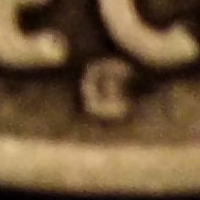
A closer look at the “inverted” D mintmark
Adding or removing mintmarks is a common method to artificially change the value of a coin. Remove the “S” from a 1921 Walking Liberty half-dollar and watch its value raise by 300-percent. Or practice adding a “D” to a 1914 Buffalo nickel to make a 400-percent profit.
After checking several references and speaking with two dealers, I sat with a box of Buffalo nickels I have to compare the mintmarks to the one on the coin. Additionally, I consulted with the images at PCGS Photograde. After all, it could be a real, undiscovered error.
The first thing I noticed on the image and with the coins I have on hand is that the mintmark on this coin is too defined for the grade. When comparing the coin to the images on Photograde, if the coin was sent in for grading it would probably be assigned a grade of G-6 of VG-8. Because of the worn rims, this coin would not grade higher than VG-8 and could be assigned a G-4.
As I was looking at the coins, those that would grade VG-8 or lower with worn rims also had mintmarks that were almost worn into the rim. In more than a dozen examples from my box, the mintmarks on all of the low-grade coins showed the rims and mintmark worn together.
Another aspect of the mintmark that bothered me was that the “D” seemed smaller than those on the coins I was looking at. For comparison, I pulled out my album with higher grade Buffalo nickels and found that the mintmark was similar in size to those in higher grades.
-

-
According to PCGS Photograde, this 1921 Buffalo Nickel represents a VG8 grade.
-
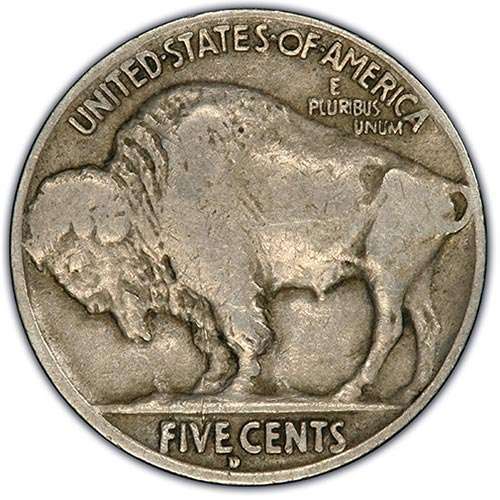
-
Look at the “D” mintmark on this 1929-D nickel graded F12 as part of PCGS Photograde
Then there is the coloring around the mintmark. Comparing it to the examples in my box, the dirt patterns around the “D” seems off. While the coloring around all of the letters appears to be uneven, there appears to be a consistent line around the “D.” In fact, the coloring at the bottom of the “D” is inconsistent with that of the other letters around it.
If I had the coin in hand, I would be able to examine it closer with a 15x loupe. I would even attempt to pick at it with a toothpick to see if the “D” would fall off. However, given all of the issues with the coin based on the images alone, I am reasonably certain that the “D” was added by someone outside of the U.S. Mint.
Of course, if you have your own theories then please post them as a comment, below.
PCGS Photograde images courtesy of PCGS and can be found
here.
Aug 29, 2018 | coins, commentary, counterfeit, ethics, foreign
A regular reader was upset about the appearance of hypocrisy at the
World’s Fair of Money. On one hand there was a lot of talk about counterfeit collectibles from China. On the other hand, there was a lot of hoopla over the Panda with special designs and privy marks honoring the World’s Fair of Money. In this episode of “LOOK BACK,” I update what
I wrote in February 2014 about China and counterfeits.
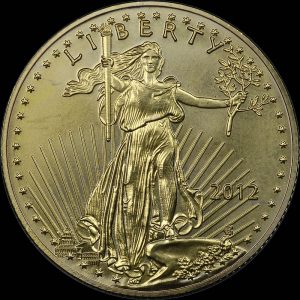
Front of a counterfeit 2012-dated American Eagle $50 denomination one-ounce gold bullion coin. (Photo courtesy of Numismatic Guaranty Corporation.)
Every coin minted by the U.S. Mint is legal tender and are legally an instrument of the government. Although the Trade dollar was demonetized in 1876, it was remonetized as part of the Coinage Act of 1965 making it legal tender (31 U.S.C. § 5103) for trade in the United States. This means that it is legal to spend an 1873 Trade Dollar for $1 of goods and services even though the coin is worth more than its face value.
To protect its currency, the United States has anti-counterfeiting laws that makes it illegal to counterfeit the nation’s money and use in commerce. For collectible coins and currency congress passed and has since updated the the Hobby Protection Act (15 U.S.C. § 2101 et. seq.). These laws protect the money supply when it is a collectible and not an instrument of commerce.
In the United States, laws are cumulative. Once passed, they remain the law until repealed or declared unconstitutional by the courts. This is not the way in many other countries. In many countries, when a new government takes power they are given the authority to rewrite the laws. It is expected to happen within authoritarian governments but it is common in many parliamentary democracies.
The People’s Republic of China has been run by the Communist Party since 1949. Their rules and laws have changed significantly when the Communist Party came into power. One of their first rules was to demonetize the money produced by the Republic of Chin and issued renminbi, the “people’s currency.”
Since then, it has been the practice of the chairman of the Communist Party to demonetize non-current issues of coins and currency as part of their economic control policies. Based on the current Chinese economic system, all coins struck since 1955, the first issued under the current government, are legal tender. Currency printed since 1999, the fifth series is the only legal tender notes. Any other coin or currency note has been demonetized.
Under Chinese anti-counterfeiting laws, it is illegal to duplicate any legal tender coin or currency note for any reason. However, since coinage from previous regimes is no longer legal tender, it is legal to strike coins with those designs. Chinese laws do not recognize the collection of these coins as a market to protect.
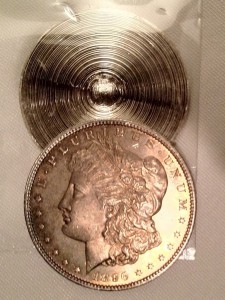
An example of a Morgan Dollar cut in half to match a date with a mintmark to have the coin appear something it is not. Coin was in a counterfeit PCGS slab and caught by one of their graders.
Chinese law does not recognize the perpetual legal tender status of every coin issued. Chinese law also recognizes that counterfeiting current issues of other countries is also illegal because someone could try to use the coin in commerce where it is legal to use foreign currency. This means that in China, it would be illegal to reproduce a presidential dollar or Washington quarter, but producing Morgan dollars or a set of 1921 Walking Liberty half-dollars is legal in China because these are coins no longer issued in the United States.
When China is asked to assist the United States to stop the counterfeiting of coins, China does not recognize that its people are doing anything wrong. The coins are no longer being made, they are not in circulation, and their laws allow people to make copies of these coins. The only laws that China has regarding collectibles are laws protecting antiquities and cultural properties. This means that you cannot duplicate a Ming Dynasty vase and try to pass it off as real but it is legal to reproduce a Rembrandt masterpiece since he is not Chinese and his work was not made in China.
A trade attorney that was originally consulted for this article confirmed that when it comes to these issues, Chinese law is very protectionist. The claim is that they follow their laws consistently regardless of outside circumstances and they refuse to make exceptions citing the complication with enforcing their laws in a country with a population of more than 1.3 billion people.

PCGS representatives showed Congressmen counterfeit U.S. coins in counterfeit PCGS holders during their recent meetings in Washington, DC. (Photo courtesy of PCGS.)
The Chinese government has no incentive to help the United States or any other country fight counterfeiting in what is perceived by the Chinese as a small market problem. To put the resources necessary into what looks like a petty crime for selling inexpensive, non-circulating duplicate coins that are within Chinese law to manufacture is considered not worth their resources.
While there is anecdotal evidence that the Chinese government knows about the counterfeit trades and some officials informally support the efforts because they get kickbacks, official Chinese policy denies there is a problem.
A lot has been written about the nature of the relationship between the United States and China since President Richard Nixon’s trip to China in 1972. Neither side trusts each other nor does neither side believe each other. Today, the United States decries the Chinese for buying too much of our debt, allegations of spying, industrial espionage, and cyber crimes. The Chinese say that the United States is trying to bully the world and that these naysayers are making up the stories to scare the world into following them. The United States talks about civil rights violations within the Chinese border and the Chinese government tells the United States to mind its own business.
The greater opening of markets between the country and the increase in popularity of bullion coins has made the Chinese Panda a popular coin amongst collectors and investors. Those of us who buy these coins know that even with the production increases since 2010 new issues continue to command a premium greater than other bullion coins.
While the Chinese are happy to sell coins and be the factory to the United States, there remains an underlying tone of political and commercial hostility between the nations. A trade attorney said that the Chinese would rather keep the relationship to business between the countries that the United States should stay out of China’s domestic policy. It was explained that the Chinese central government was upset over how the United States passed judgment over companies in their high tech electronic manufacturing sector because these companies are doing better and are safer than other Chinese manufacturers. To the Chinese government, it is not a problem if a few workers die for whatever reason. There is an ample supply from the population to keep the plants running.
These are the values of the Chinese government. Whether you agree with them or not, Communist Party officials will resent anyone telling them how to manage their domestic affairs. They want advice about how to treat their citizens as much as the United States wants similar advice from China.
There is no incentive for China to stop the manufacture of counterfeit collectible coins.
It is not against Chinese law for these people to manufacture coins that are no longer in production. Chinese people who are manufacturing these coins are working in China and many employ other people. It means there are fewer people relying on assistance the Chinese government provides. Since they now have incomes, it provides revenues for the tax coffers.
When a United States trade representatives negotiate with their Chinese counterparts, it gives the Chinese a chance to lecture the United States how they resolved the counterfeiting issues which leads to a discussion on currency handling and management, which is a sore subject in the United States since the United States questions Chinese monetary policies.
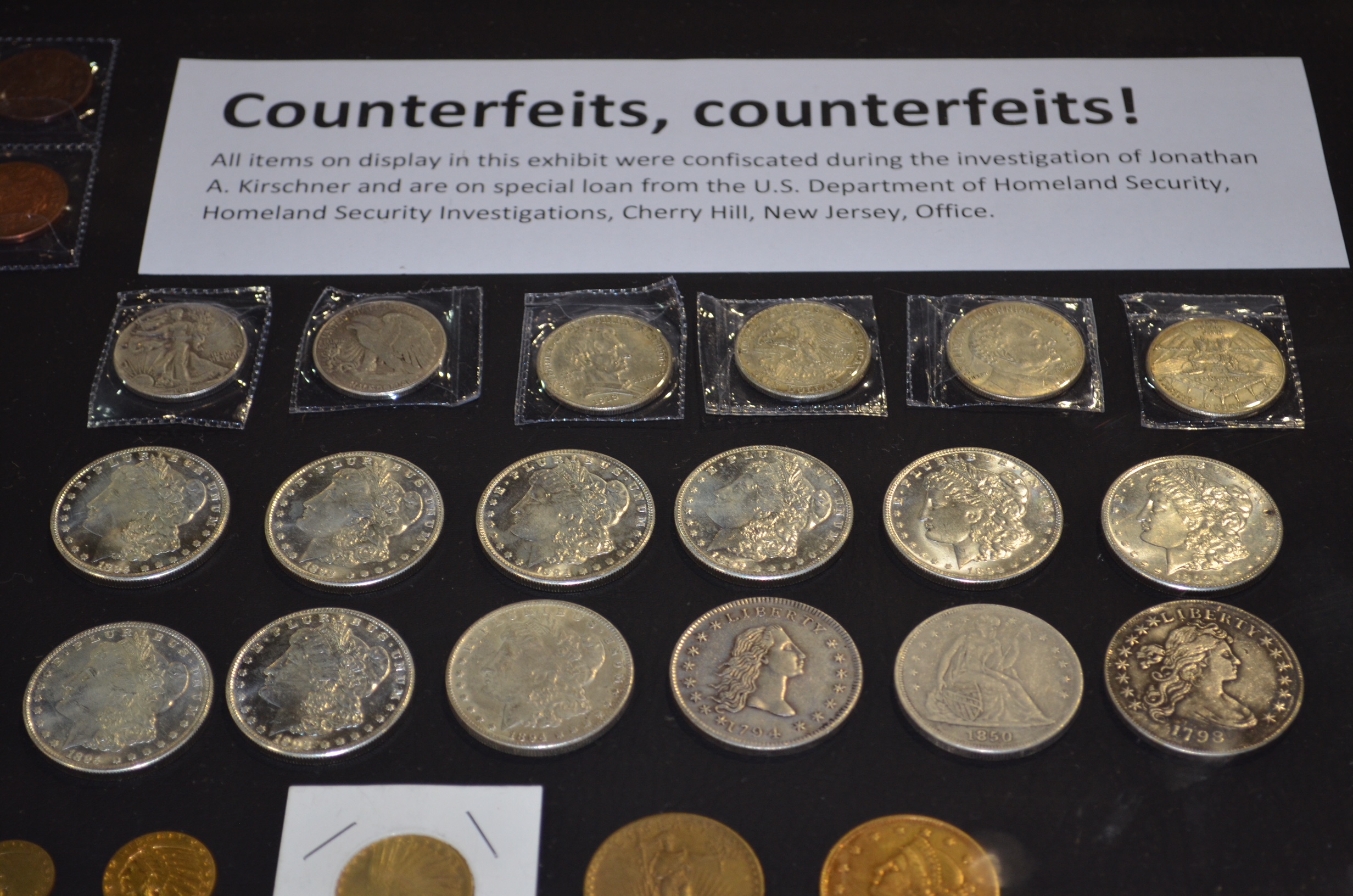
A portion of the exhibit of confiscated counterfeits on special loan from the Department of Homeland Security displayed at the 2018 World’s Fair of Money® by ICTA/ACTF.
Finally, it gives China a measure of moral superiority against the United States. After all, China figured out a way to prevent the impact of counterfeiting of older currency, why can’t the United States do the same?
China has no incentive to help the United States to solve a problem that they perceive does not exist. It is up to the United States to resolve these issues. This is why the industry promoted the Collectible Coin Protection Act (Public Law No: 113-288) so that law enforcement has an additional tool to use to help prosecute handlers of counterfeit coins in the United States.
You can read the original article
here.
Feb 22, 2018 | commentary, counterfeit, currency, education, scams, security
It is difficult to turn on the television, read the news, or visit social media without the tragedies of the day smacking us in the face. Although crime statistics are the lowest it has been in generations, there are some crimes that have seen a rise. Those are the crimes that are given the headlines and the most airtime on the news.
Unfortunately, the news extends beyond the mainstream but extends to Main Street.
Numismatics has not been a stranger to the criminal element. If it is not embezzlers using coins to defraud people and governments, there are the counterfeits primarily coming from China. Now there are two new scams that the industry has to watch.
Counterfeiting currency is definitely not a new issue. Counterfeiting the currency that is supposed to be the most secure is something that is now hitting the mainstream, especially in countries that have adopted the use of polymer notes, is important news.
Police in Saskatoon, Saskatchewan has reported the confiscation of 72 bogus Canadian banknotes. Counterfeiters are using a combination of printed plastic sheets and physical cut-and-paste of lower denomination notes to mimic higher denomination notes.
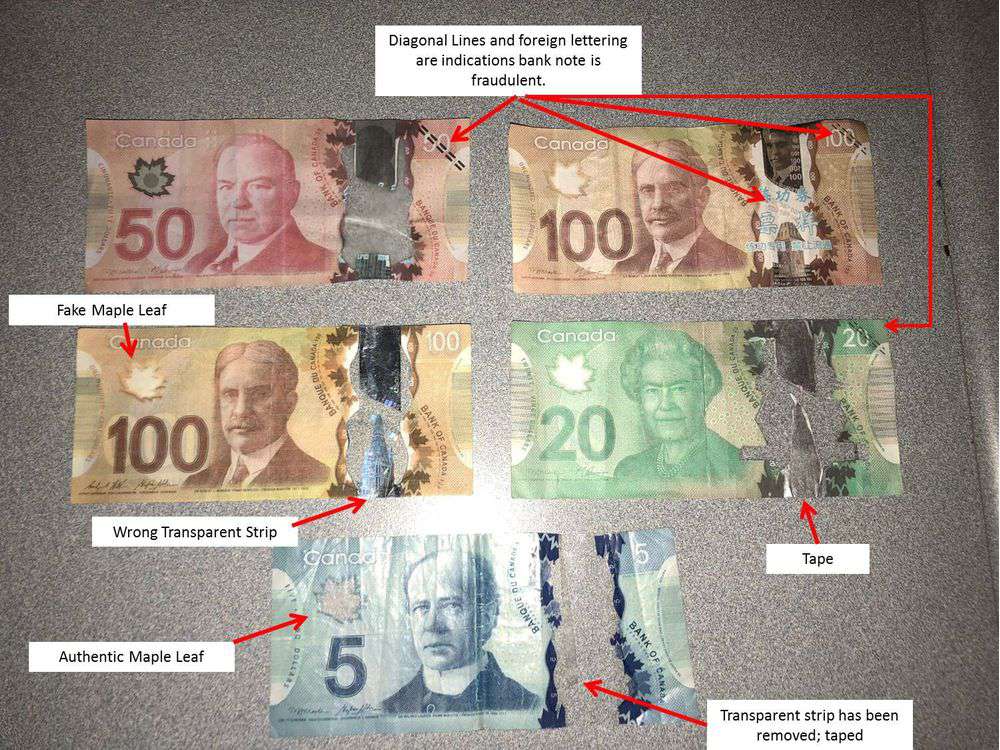
Image released by the Saskatoon Police showing the counterfeit currency (Image courtesy of the Saskatoon Police via the Saskatoon StarPhoenix)
Within the same news feed, the Bank of England issued warnings and additional guidance after counterfeit notes were used for purchases at pubs in Lincolnshire. Many stories from the U.K. suggest that the people do not seem to like the new polymer notes, but this does not seem to help.

Bank of England wants people to watch for the color shifting ink in the quill (Bank of England image)
The Reserve Bank of Australia (RBA), Australia’s central bank and the primary developer of the polymer substrate used around the world, has found that their currency is under attack by industrious forgers. One particular forger found a plastic substrate similar to the polymer developed by the RBA. The forger bought one high-quality commercial printer from the used market and rented two others to print Australian $50 notes.
According to the reports, the $50 note was picked because it provides is common enough to be used in daily transactions (AU$50 is equivalent to US$39.06 as this is being written) and high enough of a denomination to be cost-effective for the forger. Remember, forgery may be a crime but it is a business.

A counterfeit Australian $50 note has the wrong security stripes and the star field on the right is supposed to be clear (Image courtesy of The Sydney Morning Herald)
Although these issues have not directly affected the collectible currency market, it has had an effect on the dealers when their customers pay in cash. Even with the rise of electronic transactions, many European dealers continue to do over-the-counter sales using cash. In some countries, like Germany, cash is still king even when purchasing rare coins.
While discussing these issues with a dealer based in Germany, it was reported that he will not accept large sums of cash from customers he has not done business with in the past. This dealer does not accept credit card payments over 200€ or for any bullion-based transactions. His regular customers can directly wire the funds to a special account the dealer set up. Others must use certified bank checks.
This is not to suggest wire transfers are safe. In a blog post on Kovels.com, they have been contacted by antique dealers that reported money stolen by wire transfers. According to the blog post:
The fraudsters hack your emails and insert their own email, cloned to look like an email from a trusted person, into your email stream. They then request a wire transfer — providing all needed wire instructions — for something that looks legitimate. Once a bank wire is sent, it is extremely difficult, if not impossible, to get the money back. If you need to send a wire, be sure to use “old” technology and confirm on the telephone with someone that you know!
Even though I am no longer in the information security business, it is still my obligation to remind you that EMAIL IS NOT A SECURE FORM OF COMMUNICATION! Email is the electronic equivalent of a postcard. Any message you send, unless it is encrypted, can be read, scanned, snooped, and even altered by anyone, anywhere, at any time.
“Oh, it cannot happen to me!”
I used to hear that line when I taught a senior-level college class on information security. Using a laptop connected to an overhead projector, I was able to show the class how easy it was not only to create spam but to make it look like an email was sent by someone else. I was also able to demonstrate how to read the email traffic on the local network with a few keystrokes. Are you using wireless connections? You just made stealing your information easier for the hacker.
Counterfeiting and wire fraud are not just problems for dealers. When dealers are defrauded by these criminals, they have to recover the money in some way. Insurance does not cover all losses or the extra security that will be required to protect their transactions. Prices will have to go up to cover the losses and the future costs of doing business.
The cost of doing business in this environment is not a trivial subject. While dealers of all types of collectibles want you business, fraudsters are making it difficult for dealers trust the off-the-street buyer. This makes counterfeiting and fraud a problem for everyone.
Oct 12, 2017 | Britain, coins, counterfeit, errors, foreign
 As the British are winding down the use of the Round Pound, stories are once again popping up about errors of the new 12-sided pound coin being sold for high prices on eBay.
As the British are winding down the use of the Round Pound, stories are once again popping up about errors of the new 12-sided pound coin being sold for high prices on eBay.
Although the Royal Mint has admitted to manufacturing issues in trying to produce enough new pound coins to satisfy circulation requirements, their claim that the number of errors where the center are missing of the bi-metallic coins is likely post-minting errors.
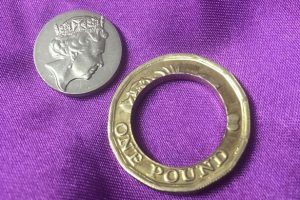
A weak strike can prevent the two metals from fusing properly allowing them to separate
To better understand why it is being claimed these are post-mint errors, I contacted a European-based dealer who has relationships with many of the continent’s mints. What follows is a summary of his explanation.
The Royal Mint coins money in a process similar to any other mint. Planchets are prepared, sent the coining press, stamped, dumped into a hopper, and sent down a conveyor where they are bagged. The bags are weight to a precise weight before the bags are accepted. Along the way, there are cameras and other sensors to detect errors.
All of the checks and sensors, including the weight of the coin, would be caught long before reaching the bagging section. Aside from the dimensions not being correct, the weight of the ring or center by themselves would not be up to the standard.
It is possible that the coins could separate in the bags during transport. However, these coins are transported to government authorized handlers. Some of them are similar to the companies that drive armored trucks here in the United States. They take the coins and prepare them for delivery to the banks.
The preparation process requires coins to be counted, rolled, and bagged. As part of the process, the coins are loaded into a system that transfers them to an automated line that brings the coins by conveyor to a machine that will either roll them or dump them in a bag. In both cases, the contents are limited by the amount they hold.
As part of the automated system, the coins are counted and check for size and weight so that if there are any coins that do not meet the Royal Mint’s standards are removed. The automated system would catch the ring and the center if they separated before the process.
Coins that are to be rolled are sent to a machine to roll them where they are counted and placed in rolls of £25 each. Those rolls are for bank and retail use and handled accordingly.
Bagged coins are used by bulk handlers such as the coin-op industry. Bags with £100 of coins are counted before being placed in the bag. If the coin cannot be verified before it is placed in the bag then the coin is rejected.
Is it possible for the coin to separate in the £100 pound bag prior to circulation? Of course, it is. However, there is one more check before the coins reach the consumer, and that is the coin-op machine itself.
Coin-op machines have mechanisms to try to prevent accepting counterfeit money and to ensure it is giving the proper change. Machines just do not eject any coin in its hopper. These checks include the weight, dimensions, and magnetic signature. The magnetic signature measures what happens after magnetic energy is flashed on the coin. Think about it as measuring how the coin would reflect light but use magnetism instead.
A pound coin that had separated would not pass the magnetic signature test and be rejected.
Although there are a number of points along the process that could fail, the number of checks between the Royal Mint and the consumer, it is highly unlikely that all of these separated pound coins exist.
It is possible that the coins being sold are from the reject bins of coin-op machines. However, the dealer I spoke with is suspicious of the number of coins being sold.

Trial strikes found without the effigy of Queen Elizabeth, II
My dealer contact said that nobody should pay more than “three-and-a-half quid” (£3.50 or $4.64 at the current exchange rate) for just a 12-sided pound outer ring. Even if it is not a legitimate Royal Mint error it is a nice conversation piece.
Examples of legitimate 12-sided £1 coin errors
-

-
Too hard of a strike is likely to have caused the copper-nickel center to melt across the coin.
-

-
First new £1 coin error found with missing detail on the thistle
Sep 13, 2017 | commentary, counterfeit, grading
 On September 12, Apple opened the Steve Jobs Theater on their new campus in Cupertino with an announcement of new hardware. There was the new Apple Watch 3, Apple TV-4K, and two new iPhones.
On September 12, Apple opened the Steve Jobs Theater on their new campus in Cupertino with an announcement of new hardware. There was the new Apple Watch 3, Apple TV-4K, and two new iPhones.
Outside of the tech press, everyone is focused on the iPhone X, “X” for the Roman numeral 10, a marvel of engineering but will cost $1,000. Breaking that $1,000 barrier is a big thing because it makes the iPhone X the most expensive smartphone on the market.
But I see another story that can be more important to a lot of other markets than the price of the device. It is the technology that can be industry altering.
Both the iPhone 8 and iPhone X have dual-lens cameras that are designed to enhance the use of photography. The new cameras have larger sensors that pick up more pixels of information with a processor that can better process the image.
It is the image processing and the iPhone’s ability to use the detailed images to map the terrain, textures, and to use augmented reality (AR) to enhance what the camera sees.
An area where this technology can help numismatics is with computer-based grading.
Computer-based grading was first tried in 1991 using the technology of the day. While it was a good start, the technology was just not ready for the ability to grade coins.
Apple proved that the technology is ready to try again.
Human-based grading has led to an environment of mistrust amongst the grading services. It is the failure of humans to be consistent in grading that leads to religious-like arguments as to which grading service is better. These failures have led the creation of verification services to check up on the ability of grading services to do their job.
The ability for the imaging process to visualize and analyze thousands of polygons on an image, the way imaging technology visualizes the three-dimensional surface, in such a way to allow for real-time expression processing and rendering can be used to assess the surface of a coin.
Another problem that can be resolved is the crack out game. Some people will crack coins out of their slabs to submit them to the grading services multiple times to play on the failure of humans to be consistent to try to have the coins graded higher. The information created based on the surface analysis of the coin will result in digital data that should be unique to each coin. Minute scratches and other environmental factors can help distinguish one coin from another in the same manner that there are subtle differences that can detect on identical twin from another.
Creating a digital signature for each coin will help prevent theft or help law enforcement use the information to track stolen items.
Imaging analysis can look at the surface to find alterations like the use of a chemical that would change the surface. Rather than using the “sniffing” technology that Professional Coin Grading Service has pioneered to find chemical additives, a surface analysis can detect chemical-based alterations to the surface.
Altered surface detection can also be used to detect unnatural toning. It will require teaching the imaging systems to detect the differences between natural and unnatural toning, but the long-term benefits to the hobby will be tremendous.

Device that could metallic analysis of a coin below the surface
In the short term, this will not put the third-party grading services out of business but it will change their business. They will not be grading and regrading coins. The computer will analyze the coin, provide the owner with a report, and that report will be consistent regardless of the imaging process used. Otherwise, the coin was altered and you would know about it.

Counterfeit U.S. coins in counterfeit PCGS holders (Photo courtesy of PCGS.)
This technology will eliminate the verification services. There will no need for a human to verify the human-based grading. After all, the fourth-party verification process is artificially driving up the costs of collector coins because of blind trust placed in humans verifying humans.
Although I spent nearly all of my adult life in the technology industry, I am not for technology completely taking over all aspects of our lives. There is a level of trust in the hardware and software that must be earned to have me feel comfortable with things like self-driving cars or even maintaining personal information (see the recent Equifax breach).
However, I am for the use of technology where it can solve a problem. Technology can solve the problem of inconsistent grading. Technology can solve the problem of coin identification. Technology can solve the problems with counterfeiting. Why not use technology to increase the trust in the numismatic market by fixing these problems?
It is now time that technology was put to use in the numismatic and collecting industries in order to create a level of assurance for the collector that their item is genuine and the condition is what the collectible is being represented as.
Credits
- iPhone X image courtesy of Apple.
- Niton scanner image by the author.
- Counterfiet PCGS slabs courtesy of PCGS
Jun 13, 2017 | counterfeit, currency, foreign
As I continue my research into history and technology of counterfeiting, I have been collecting historical statistics as to the problem of counterfeiting. I thought I would share the current statistics I found.
The most common counterfeited denomination is the 20s, be they dollars, pounds, euros, or pesos. For currencies whose values are significantly lower than the dollar, such as the yuan, or whose currencies have no real fractions, like the yen, the most common counterfeited denomination is the 100 unit.
Canada

The top note is a counterfeit $100 note, the bottom is a legitimate note
United Kingdom

Detecting counterfeit £1 coins, the genuine coin has edge lettering (left), the counterfeit does not.
The Bank of England began issuing currency using the polymer substrate starting with the £5 notes. The paper fiver was withdrawn on May 5, 2017 (withdraw the £5 on 5/5… get it?!). Plans continue to issue the £10 note in September.
The move to polymer notes was prompted because of a spike in counterfeiting in 2012. Spiking at more than 746,000 counterfeiting notes with a value of £13.71 million, the Bank of England reports that 347,000 counterfeit notes valued at £7.47 million were confiscated in 2016.
Euro
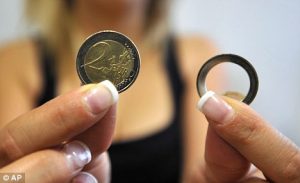
Eurozone has had more problems with counterfeit €2 coins than currency.
The ECB is in the process of transitioning their currency to the new Europa Series. A new €50 note was issued this past April. Aside from new designs, the Europa series uses some of the advanced technologies to prevent counterfeiting but does so on cotton bond. Currently, there is no plan to use the polymer substrate for the Euro notes.
China
As opposed to other central banks, the People’s Bank of China (PBC) is not as forthcoming with information. But when they do something, news reporters can obtain some nuggets of information from Chinese officials. When the PBC unveiled new 100 yuan notes with additional counterfeiting features, they reported to the Wall Street Journal that police confiscated 532 million yuan ($85.6 million) in counterfeit bills in 2014. The most commonly counterfeited notes were 50 yuan and 100 yuan bills but there have been increases in lower denominations.
Mexico
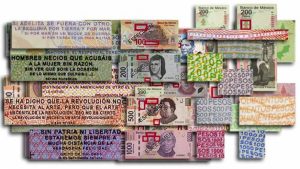
Click on the image to read a nice description (in English) on identifying genuine Mexican currency
Statistics published by the Bank of Mexico reports a decrease in the number of counterfeit currency from 70.7 per million issued to 61.8 per million notes issued. This represents a decrease of 12.6-percent. When the Bank of Mexico issued the new polymer 20- and 50-peso notes in 2014, they experienced a drop in 36.9-percent in counterfeiting.
United States
It is not a surprise that the world’s most use currency and the currency that most world trade is based is the most counterfeited currency in the world. There is also more United States currency in circulation that any other, including the Euro. According to the Federal Reserve, there is approximately $1.49 trillion in Federal Reserve notes circulation. The Federal Reserve Bank of San Francisco says that 31.1-percent of those notes is the ubiquitous dollar and 26-percent are $100 Federal Reserve Notes mostly held overseas.
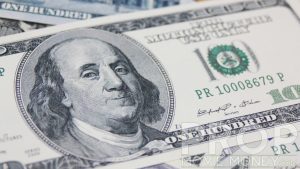
Prop Movie Money continues to be a problem because people just do not look!
The $20 bill is the most commonly counterfeited banknote in the U.S., while overseas counterfeiters are more likely to make fake $100 bills.
In every report downloaded from the various governments and central banks regarding the security of their currency, it is a common theme that the vast majority of counterfeiting would have a minimal impact if people would just look for the anti-counterfeiting measures these entities go through great lengths to add to the currency. Whether it is not looking for the edge lettering on the old round-pound or the recent cut-and-paste of the security features of Canadian currency, there would be few problems if people would just look.
Credits
- Canada counterfiet currnecy image courtesy of CTV News.
- Counterfeit round-pound image courtesy of BBC News
- Counterfeit €2 coins courtesy of The Daily Mail
- Mexican currency image courtesy of Bajainsider.com.


 This past week has been interesting for the precious metals markets. When the market seems like it will take off, prices modulate and lay flatter than a pancake. Predictions as what the markets will do are all over the place without a consensus answer from analysts.
This past week has been interesting for the precious metals markets. When the market seems like it will take off, prices modulate and lay flatter than a pancake. Predictions as what the markets will do are all over the place without a consensus answer from analysts.  → Read more at
→ Read more at 

























